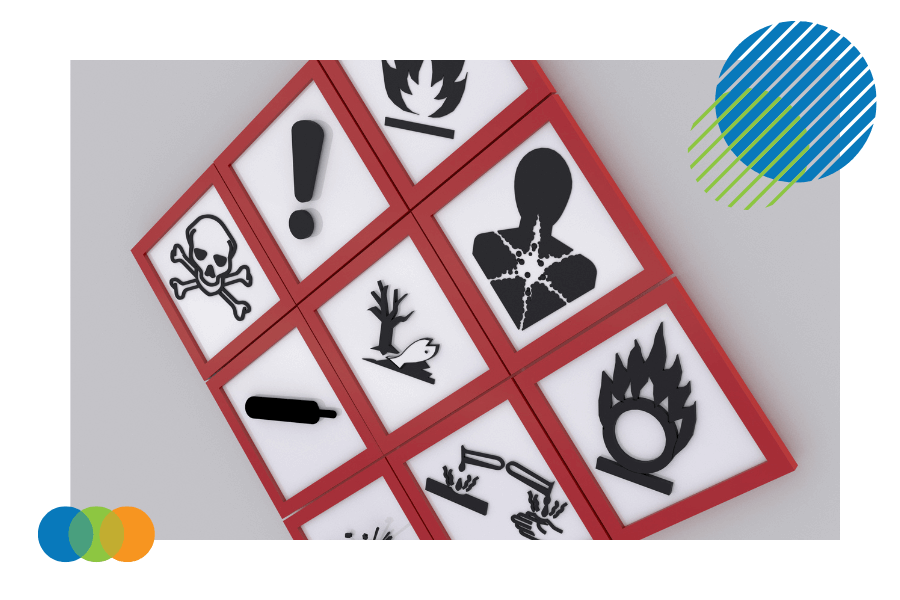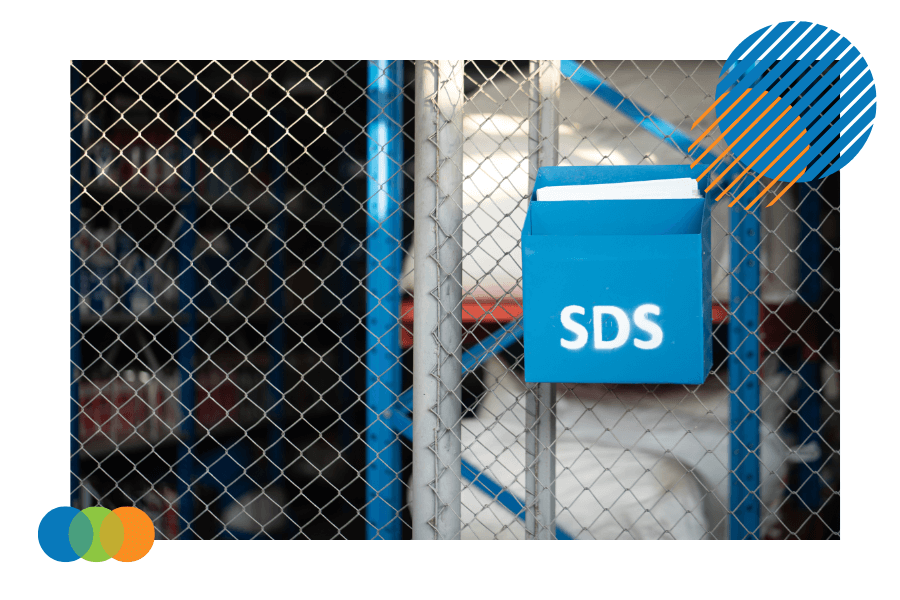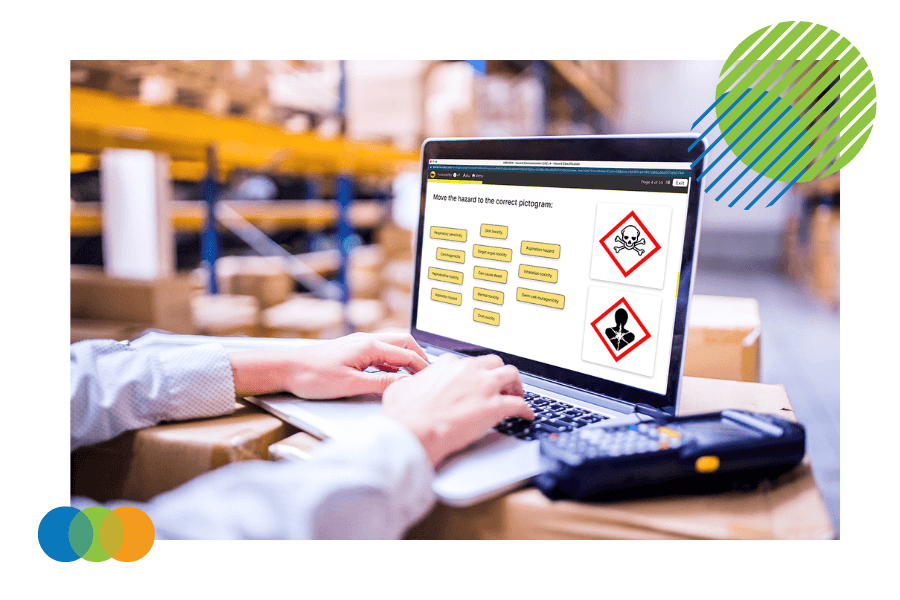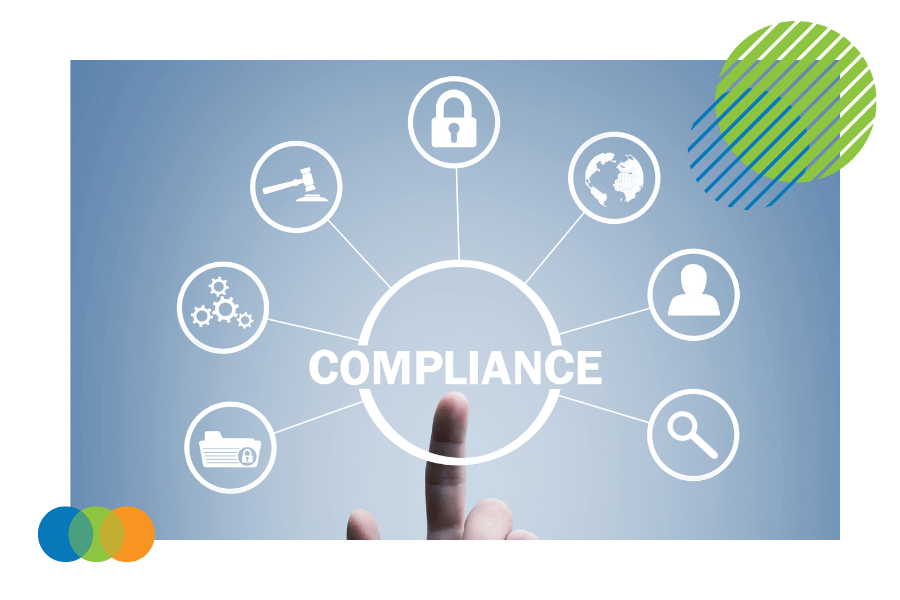 |
Written by Liz McDermott |

Canada's Workplace Hazardous Materials Information System (WHMIS) training helps prevent accidents and injuries by providing staff with knowledge of the potential hazards and proper storage and handling procedures of chemicals. The WHIMS training guidelines and protocols can reduce the risk of accidents, spills, and exposure to harmful substances.
Let's explore how this education empowers staff to protect themselves and their colleagues from risks and ensures a safer working environment.

TABLE OF CONTENTS:
- The Key Elements of WHMIS 2015 Training
- Who should receive this education and training?
- WHMIS Course Content
- WHMIS Certificate of Completion
- How Often Does WHMIS Training Need to Be Reviewed?
- WHMIS Education Considerations
- Understanding the WHMIS Training Regulations
- How to Choose the Right WHMIS Training Program

The Key Elements of WHMIS 2015 Training
WHMIS 2015 training covers many essential elements to ensure workplace safety and compliance. These fundamental elements include Globally Harmonized System (GHS) hazard identification, product classification and labeling, and safety data sheets (SDS).

Globally Harmonized System of Classification
GHS Hazard Identification
It involves identifying and understanding the potential hazards associated with using, handling, and storing hazardous products. This includes recognizing the different types of hazards, such as physical, health, and environmental hazards.
GHS Product Classification
It involves categorizing hazardous materials based on potential risks and determining the appropriate precautions and safety measures. This classification system helps staff understand the severity of the hazards and the necessary protective measures.
GHS Labeling
Proper labeling ensures that hazardous materials are identified, allowing staff to recognize potential risks and take appropriate precautions. Labels include the product name, supplier information, hazard symbols, and precautionary statements.

Safety Data Sheets (SDS)
Safety data sheets (SDS) provide detailed information about hazardous materials, including their properties, handling procedures, and emergency response measures. WHMIS education covers the importance of accessing and understanding the structure of a safety data sheet to ensure the safe handling and storage of hazardous products.
Who should receive this education and training?
All staff who work with or may be exposed to hazardous products should receive WHMIS education and training. This includes full-time workers, part-time workers, temporary workers, and contractors. Regardless of the duration or nature of their employment, anyone who may come into contact with hazardous materials should be adequately trained to ensure their safety and the safety of others.
The employer is responsible for identifying and assessing the staff who require WHMIS training based on their job duties and potential exposure to hazardous materials. This includes anyone working in manufacturing, construction, healthcare, laboratories, and janitorial services.
By providing WHMIS education and training to all relevant populations, organizations can ensure a safer working environment, reduce the risk of accidents and injuries, and comply with WHMIS regulations.
WHMIS Course Content
A comprehensive WHMIS education program should cover various topics to ensure a thorough understanding of workplace safety and compliance. Some of the essential training topics that should be covered in a WHMIS training course include:
- Overview of WHMIS: This section provides an introduction to WHMIS, its purpose, and the legal requirements associated with it.
- Hazardous Materials: It is important to understand the different types of hazardous products and their potential risks. This section covers physical, health, and environmental risks.
- Hazard Communication: This section focuses on properly communicating hazards through labeling, safety data sheets, and other means.
- Product Classification: Understanding how hazardous substances are classified and the associated risks is crucial for safe handling and storage.
- Personal Protective Equipment (PPE): This section covers the importance of using appropriate personal protective equipment and correctly choosing and using it.
- Emergency Procedures: In case of accidents or spills, knowing how to respond quickly and effectively is essential. This section provides guidance on emergency procedures and the importance of reporting incidents.
- Worker Rights and Responsibilities: Workers need to understand their rights and responsibilities regarding workplace safety. This section covers the right to refuse unsafe work and the importance of reporting hazards.
- Case Studies and Practical Exercises: To reinforce the knowledge gained during the training, case studies and practical exercises can be included to simulate real-life scenarios and encourage active participation.

WHMIS Certificate of Completion
Upon completing the training program, staff should receive a WHMIS certificate of completion. This certificate serves as documentation that the employee has obtained the necessary education and training to handle hazardous materials safely. It can be used as proof of compliance with WHMIS regulations during inspections or audits.
The certificate of completion should include the employee's name, the training provider's date, and the training provider's name. It should also indicate that the training covered the necessary WHMIS topics and met the regulatory requirements. Companies should keep a record of these certificates to demonstrate their commitment to workplace safety and compliance.
The certificate of completion provides peace of mind to employers and serves as a tangible recognition of the employee's efforts to ensure workplace safety. It reinforces the importance of WHMIS education and acknowledges the employee's role in creating a safe working environment.
How Long Is WHMIS 2015 Certification Valid For?
As an employer, it is essential to understand the validity of the WHMIS 2015 certification. WHMIS certification does not have an expiration date. However, it is recommended that companies provide refresher training to their staff regularly. The frequency of refresher training depends on several factors, such as the nature of the work being performed, the level of risk involved, and any changes to the hazardous products used in the workplace. It is generally recommended that refresher training be provided at least every three years or when significant changes to the hazardous materials or processes used in the workplace occur.
How Often Does WHMIS Training Need to Be Reviewed?
WHMIS training is not a one-time event; it requires regular review and updates. The frequency of review depends on various factors, such as changes in hazardous products used in the workplace, new regulations, or the introduction of new products. As a general guideline, it is recommended to review WHMIS training at least once every three years. However, if there are significant changes in the workplace or the introduction of new hazardous materials, more frequent reviews may be necessary.
Regular review of WHMIS training ensures staff are up-to-date with the latest information and safety protocols. It also provides an opportunity to reinforce important concepts and address questions or concerns. By staying current with WHMIS training, employers can maintain a safe working environment and comply with regulatory requirements.
WHMIS Education Considerations
The inventory of hazardous products used in a workplace is crucial when designing WHMIS education. It is essential to tailor the training to address the specific hazards present in the workplace. This includes considering the types of hazardous materials, their quantities, and the potential risks associated with their use, handling, and storage.
By conducting a thorough inventory assessment, employers can identify the specific training needs of their staff. For example, if a workplace uses corrosive substances, the training should focus on safely handling and storing such materials. Similarly, if the workplace deals with flammable liquids, the training should emphasize fire safety and the proper use of fire extinguishers.
Considering the inventory at the workplace ensures that WHMIS training is relevant, targeted, and effective in addressing the specific risks workers may encounter. It helps create a safer working environment and reduces the risk of accidents and injuries.

Understanding the WHMIS Training Regulations
Employers and employees must thoroughly understand the Workplace Hazardous Materials Information System (WHMIS) 2015 regulations to ensure workplace safety and compliance. The regulations outline the responsibilities of employers and employees and the necessary training and precautions to be taken when working with hazardous chemicals.
Worker education and training are essential to ensure that staff are knowledgeable about the risks they may encounter in the workplace and how to protect themselves effectively.
What are the employers' duties?
Employers are responsible for ensuring that all staff who work with or may be exposed to hazardous chemicals receive adequate WHMIS training. This includes new employees, temporary workers, and contractors.
Employers are responsible for reviewing and updating the WHMIS program as needed. This includes conducting regular workplace assessments, identifying changes in hazardous materials, and providing additional training when necessary.
What are the workers' duties?
While employers have specific duties, workers also have WHMIS training and compliance responsibilities. Workers must actively participate in the WHMIS training provided by their employers. This includes attending training sessions, asking questions, and seeking clarification.
If I change employers, do I have to retake WHMIS training?
If you change employers, you will likely need to undergo WHMIS training again. The requirements may vary depending on the new employer's policies and the nature of their operations. It is essential to check with your new employer to determine their WHMIS training requirements.
Even if you have previously received WHMIS training, it is advisable to undergo refresher training when starting a new job. This ensures that you are up-to-date with the latest information, safety protocols, and any changes in laws. It also allows you to familiarize yourself with your new workplace's specific hazardous chemicals and procedures.
WHMIS training is a legal requirement and a critical aspect of workplace safety. By undergoing training when changing employers, and you demonstrate your commitment to safety and willingness to adapt to new workplace risks and procedures.
How to Choose the Right WHMIS Training Program
When choosing the right WHMIS training program, several factors must be considered. First and foremost, ensuring the training program complies with WHMIS 2015 regulations is crucial. It should cover all the necessary topics, including hazard classification, labeling requirements, safety data sheets, and worker education and training. It should also provide up-to-date information on changes to the laws.
Another important factor to consider is the delivery method of the safety training program. There are two main options to choose from: in-person training and online training. In-person training typically involves attending a workshop or seminar, where an instructor provides the necessary training materials and guidance.
Conversely, online training allows workers to complete the training at their own pace, usually through an interactive online platform. Both options have advantages and disadvantages, so it is vital to consider your employees' specific needs and preferences when deciding.

Conclusion: The Benefits of WHMIS Training for Employers and Employees
In conclusion, WHMIS training is essential for ensuring workplace safety and compliance. By understanding the WHMIS 2015 regulations, employers and employees can take the necessary precautions to safeguard themselves and others from the potential risks associated with hazardous materials. WHMIS certification does not expire, but regular refresher training is recommended to keep workers up-to-date with any changes to the regulations. When choosing a WHMIS training program, it is essential to ensure that it complies with the rules and meets the specific needs of your workers. Non-compliance with WHMIS regulations can have serious consequences, both legally and in terms of workplace safety. By investing in WHMIS training, employers can create a safe and compliant work environment while protecting their employees and their businesses.
Ensure the safety and compliance of your workplace by providing WHMIS training to your workers. Choose a reputable training program that meets the WHMIS 2015 regulations and offers the delivery method that best suits your needs. Remember, workplace safety is everyone's responsibility.
For more information, please contact us to inquire about our Health & Safety training.

